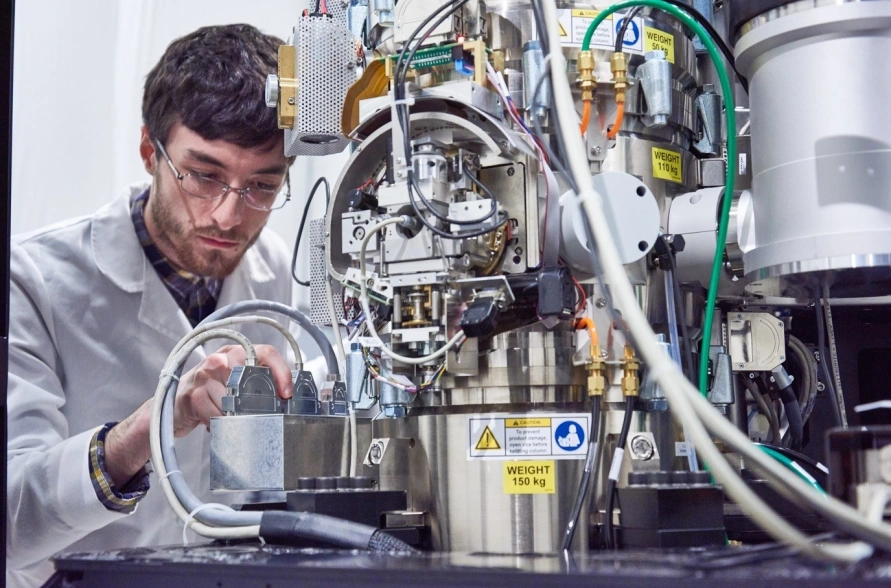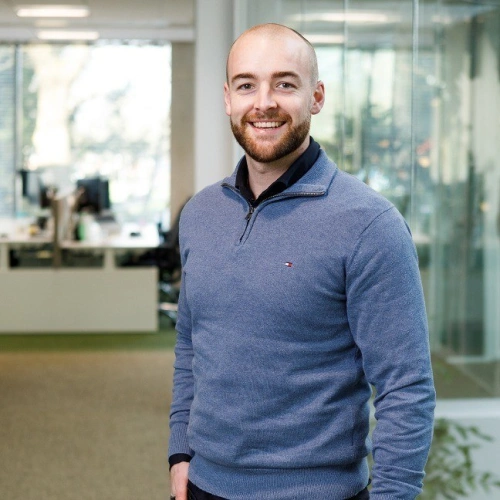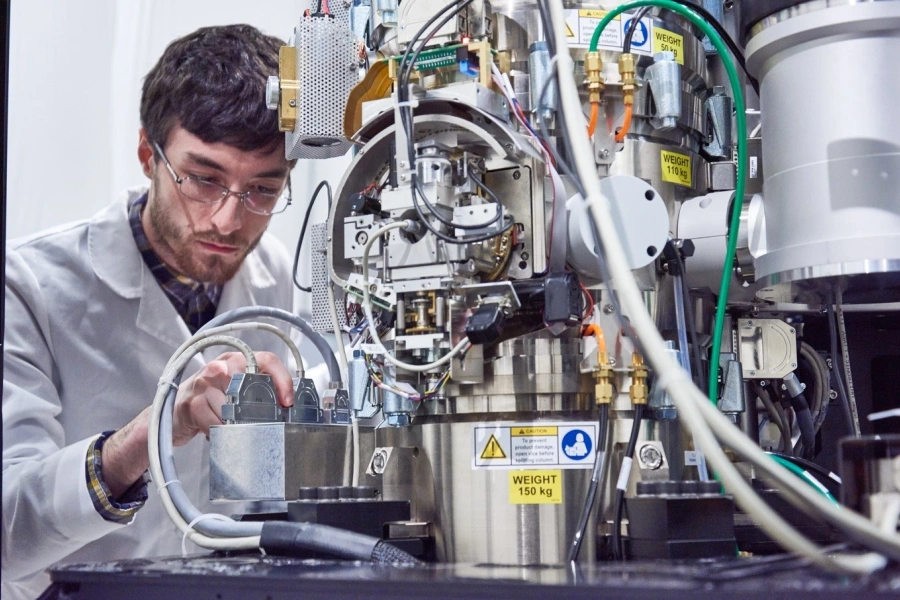The Thermo Fisher Scientific facility – at Acht industrial estate in Eindhoven – is a center of expertise for electron microscopy. Around 1,300 highly motivated and dedicated professionals with 46 different nationalities work here on innovative and reliable solutions in the field of electron microscopy. Research into new possibilities of electron microscopes and their applications also takes place here, as well as service and support for users.
Thermo Fisher is an important and innovative market leader in advanced electron microscopes worldwide. Maurits Smits, Senior Director in Eindhoven: “Bringing technological breakthroughs to the world is our daily goal and challenge. Our technology provides researchers with eyes in places that were previously unthinkable. They can visualize molecular structures at high resolution down to the scale of a picometer – much smaller than a nanometer. With that knowledge, they can make decisions to make the world healthier, cleaner, and safer. It is very rewarding to work on solutions for societal challenges. We make the impossible possible in electron microscopy. It is no coincidence that multiple Nobel Prize winners use our microscopes.
Over the years
Since 1949, Philips – initially from the NatLab – has been bringing electron microscopes to the market. The company started production under the name Philips Electron Optics. Making these microscopes requires certain electron and ion sources and columns; American company FEI has been building a lot of expertise in this field since 1971. A collaboration resulted in an acquisition in 1997. Philips Electron Optics merged into the newly established Dutch branch of the company: FEI Electron Optics BV. In 2016, Thermo Fisher showed interest due to the opportunities electron microscopes offered in fields such as life sciences and material sciences. This led to an acquisition, providing Thermo Fisher with a stronger position in these fields.
Since then, the former Philips center of expertise for electron microscopy has been part of a large American multinational with more than 40 billion dollars in revenue and over 125,000 employees worldwide. The total range of products and services is broad, but everything is aimed at enabling scientific solutions and facilitating science. Eindhoven maintains a focus on electron microscopy.

Learn more

Rich application possibilities
The electron microscopes can be used in various areas. Maurits: “With our microscopes, you can study atomic structures of substances like silicon or gallium, which is useful in the semiconductor industry. Also, atomic structures for lithium batteries, to see how we can make them more sustainable, safer, and more effective. In the health and life sciences sector, researchers are looking deeper into animal, human, and plant cells. Seeking answers to questions like: ‘why does someone get sick?’ or ‘why does this medicine work for Mr. A but not for Mrs. B?’. For that, knowledge of atomic structures of proteins is needed, the building blocks of cells and thus of our bodies. Currently, we at Thermo Fisher are helping to facilitate research into Alzheimer’s disease, COVID-19, and other medical conditions. The first images of the proteins that make up the coronavirus were obtained with Thermo Fisher microscopes. We can really make a difference for humanity.”
Brainport as a breeding ground
And all of this still from Brabant. The Brainport region is a safe haven, where high-tech and advanced design come together with high-end manufacturing. When Maurits looks out from his workspace, he sees the neighbor's office: “That is clearly a Philips building, with the colors and structures of Philips. Our ‘heritage’ is never far away. The knowledge that Philips traditionally spread is not only in our electron microscopes. Also in equipment for the semi-industry as produced by ASML and in medical implants. The technology is intertwined with multiple companies. Specialized suppliers are also here; not only for supplying product parts but also knowledge. In short: Brainport brings together experts in technology, production, business, and world-class technical universities. They share knowledge, ideas, and resources to accelerate the development of technologies. We are all gratefully making use of this within the Brainport region.”
Surfing or making waves ourselves?
Maurits doesn’t complain about regional colleagues. “We thought we had to learn to go with the flow, to surf on the waves made by other companies. Meanwhile, we know that we also make waves ourselves and are a leader in the ecosystem. And that we – together with other big players here – strengthen each other and give our suppliers a significant push forward. I always call it a kind of perpetuum mobile: once you have it, it only gets better – as long as you maintain it well. In the Brainport region, we have a lot of talent and knowledge. That attracts companies and people who want to work with and for highly innovative companies like Thermo Fisher.”
The hidden gem of Brabant
Thermo Fisher didn’t always realize what its role was in the ecosystem. Mike Houtkamp, project manager Foreign Investments at BOM: “Thermo Fisher is among the top companies in Brabant, but the company is not very well known to the public. Probably due to a combination of Brabant modesty and a complex B2B product. This is while this hidden gem makes a huge contribution to society, both regionally, nationally, and internationally.”
Maurits agrees with that. “We just did our thing, without the positive impact we created really being visible. In 2022, we decided to leave the ‘corner of ignorance’ and become more public. We do this by seeking collaboration in the region, with parties like BOM, the municipality, the Ministry of Economic Affairs, and RVO. Simply with the goal of continuing to promote growth and developments.”
Strong growth ambitions despite an overcrowded electricity network
Thermo Fisher also has big growth ambitions in Eindhoven. In 2021, the company purchased the adjacent building, an expansion of 1,100 square meters to increase production capacity by twenty percent. Maurits: “Then you have to discuss everything; subsidies, permits, electricity. Ultimately, it turned out in 2022 that due to grid congestion, we couldn’t grow in terms of electricity as much as we wanted. At the same time, Thermo Fisher is committed to reaching net zero carbon emissions or carbon neutrality by 2050. So, as a company, you start looking for energy savings and smart energy solutions.”
“BOM helped us enormously with that,” says Maurits. “That was partly in making contacts and sharing knowledge about smart energy solutions. Together we looked for solutions instead of problems. Now, mid-2024, grid congestion is still a major problem in the Netherlands. And even BOM cannot perform miracles. It seemed that we would not be able to expand in terms of electricity for the next three years. So we are focusing on various other paths: generating energy ourselves, storing it in batteries, and collaborating on our business park to better match supply and demand. And also reduce our own consumption by making our electron microscopes more energy-efficient too. If our product becomes more circular, it is more attractive for customers. We have learned to be not only innovative with our products but in every aspect of our activities and facilities. That gave us wings. In part of the new building, we can now start production without needing more electricity. Such a national energy crisis makes you extremely inventive.”
Looking ahead
Maurits notices that many companies don’t (yet) see grid congestion as their problem for today or tomorrow. “Many people assume it will be okay. But that’s not the case. Not just like that. And you can do a lot yourself, but you need to have a long-term vision. That means that as a company, you need to delve into energy issues alongside your business operations. And be well informed when new regulations arise or new opportunities arise. Because BOM is well connected to the government and has close contacts within the business community, there can also be exchanges. As a company, you can’t do everything alone. A partner like BOM can simplify this.”
Meanwhile, Thermo Fisher continues working on the electron microscopes in Eindhoven, takes its role in the ecosystem, and explores possibilities to grow further despite practical obstacles. Because that new building? It has already seen the design, construction, and commissioning of a cleanroom in just four months. And it has many more promising ideas!
